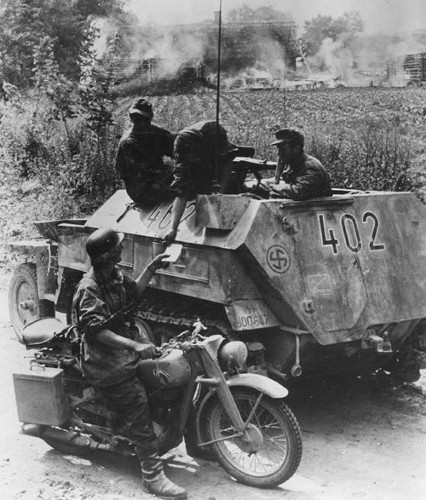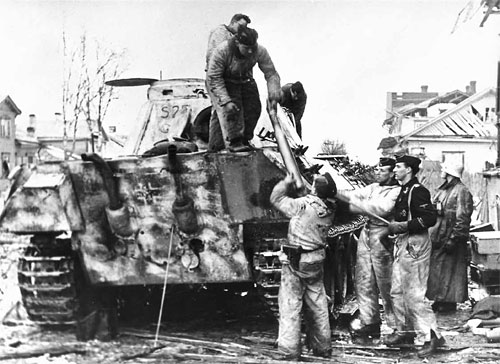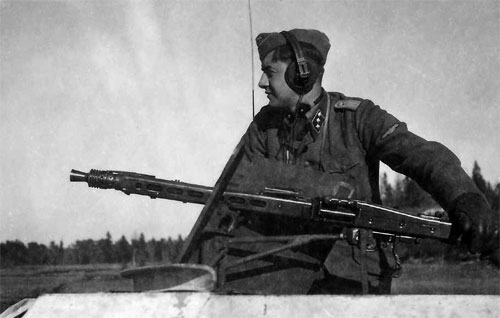
- PzKpfw V ausf. G "Panther"
- Sinimae, Estonia
- 25 July – 10 August 1944
- SS-PzAbt 11 „Hermann von Salza“, 11. SS Frw-PzGrenDiv "Nordland"
- Obersturmbannführer Paul Albert Kausch
Northern Doom
In this article, I want to tell the story of the Estonian SS because it’s really very sad. Yes, I know. I said "SS". Those were the bad people. As if the Wehrmacht never did anything naughty. But then, the Wehrmacht never had a foreign exchange program. These Estonians were blonde Ersatz-Aryans and completely dedicated to fighting the Russians, so they were allowed into the SS. By this time, the German forces needed some fresh blood. Trouble is, as far as I know, none of these guys ever came near a tank. That doesn’t suit my purposes, but I still want to tell the story. So I’m cheating.
Knight Hermann and the pagans

The story is this. Once upon a time, a long, long time ago, there was this brotherhood of dudes called Teutonic Knights. They were a medieval military order of some repute, still believed to involved with all sorts of global conspracies. And stuff. This Order was established during the Crusades in order to help Christian pilgrims during their stay in Outremer. But then, in 1226 the Duke of Masovia (north-eastern Poland, Prussia) appealed to these veteran Knights to defend his borders and crusade against the pagans to the north.
The head of the order, Hermann von Salza, thought this was a very good idea. These pagans were not soldiers but farmers and slaughtering them was good training for his army. He was, after all, planning another crusade against the Muslims and those could fight back! Not good training material, then. After thus conquering the northern lands for Christ, they also found also some pagans to the east. The Knights thought this was an excellent opportunity and decided to invade Russia. This venue ended horribly in a frozen lake and pissed off a lot of the locals.
Now we skip a couple of centuries. All right, a lot of interesting stuff happened in the mean time but I'm not writing about knights here.
After a lot of upheaval and confustion the modern Baltic countries (Estonia, Latvia & Lithuania) emerged - as buffer states between Russia and Germany. That's never a good place to be in. Then Molotov came along and poofed things up. In June 1940, the states were annexed by the Soviets. A lot of people were were sent off to the gulag, the army was “integrated” and its officers executed. When the German Army showed up in ’41 to 'liberate the people', everybody was happy. Until they found out that the Nazis deemed them mere Untermensche - but certainly fit for slave labour. They were, so to speak, fucked both ways. However, that remained mainly theory: the Nazis were far more happy killing Jews than fair-haired Estonians. So, when the Soviets came back in 1944, a lot of them joined the SS to help hold back the tide and protect their mother country. They often preferred to stay back when the Wehrmacht retreated, in order to buy the Germans time and kill as many Russians as possible while doing it. Not that it helped, though.
Tannenberg II
The battle for the Tannenberg Line (not the 1914 one) was one of these retreating battles the Estonians fought in. There were also Dutch, Belgian, Norwegian and Danish troops in situ (and Germans, obviously, Otto Carius was just a few miles to the south earlier that year.). I might pick up on the Dutch or Belgians later, but now I’d like you to meet SS-PzAbt 11 „Hermann von Salza“. I’m sure you see the historical connection there.

Now, the story I was getting to. After the German Army was forced to retreat from Leningrad, reaching Tallinn on the Estonian west coast became of major strategic importance to the Soviets. From that position they could (try to) push Army Group North out of the Baltics and pursue them into Prussia. Also, they could threaten Finland with invasion. On the way to Tallinn was the old border city of Narva and Stalin ordered it taken by the 17th of February 1944. Which they didn’t. Apparenty some generals were shot and a new offensive ordered. The Germans, however, had been arranging defensive positions for three years. They were prepared, knew the terrain and were in full control. The Soviets attacked and suffered horrible amounts of casualties for little gain but kept pushing. They tried attacking several times but were always repulsed. Without preparation or planning they tried to accomplish very difficult goals and the results were predictable: lots and lots of dead soldiers.
“As needlessly slaughtered Soviet men floated ashore, STAVKA was already planning and preparing for an attempt to assault the southern flank in the hopes of better success.”~ Major A.M. del Gaudio
In the end, though, they broke through towards Krivasoo and Auvere. An enormeous Soviet encirclement movement to the South threatened to cut off the Germans in Narva so they were forced to retreat to the Tannenberg Line. This defensive line anchored on three strategic hills near the Estonian village of Sinimaë: Hill 69.9 (or ‘Love Hill’), Grenadier Hill and Orphanage Hill. The Germans were able to make an experienced guess as to the Soviet organization and tactics. They knew enemy armor and infantry would be working together but the local natural obstacles would make movement for armor difficult and thus separate the infantry from the armor. Like Lake Peipus, the hills at Sinimaë were used to turn or fix the Soviets into engagement areas.
As is common with the Germans, a combat group was formed from several battered units and tasked with holding back the Russians. To the North was the Brigade "Nederland" and the 20. Waffen-SS Grenadier-Division (1. Estnische). The “Nordland” division was located around the Rollbahn, the main road to the west. SS-PzAbt 11 „Hermann von Salza“ was part of this division and had just received a batch of pre-production (and rather defective) Panthers. These were either repaired or dug in and used as pillboxes in a defensive position southeast of hill 69.9 near 24.SS-PzGren regt Danmark’s line, to counterattack any Soviet advance there. Later deliveries of Panther G’s (from PR 29) were very welcome indeed; the Abteilung now had its first operational Panzers.
Old School Nazi

Enter Obersturmbannführer Paul Albert Kausch, "HvS"'s commander. He was a proper old-school Nazi, one of the original "Leibstandarte" members. After his training in Braunschweig he spent a while as platoon and company commander with "Totenkopf". In 1943 he was sent to command the new 11. SS PzAbt. "Nordland" which was later renamed "Hermann von Salza". What we know about his time near Sinimae is, like in so many cases, very little.
Russian General Govorov (2nd Baltic Front) had 11 guards divisions and 6 tank divisions at his disposal. At noon on July 29th the Red Army attacked from the direction of Lembitu with 20,000 men and 100 tanks. Their armoured spearhead was blunted by 12 patched up StuGs commanded by Kausch's colleague, Stuebben. However, the Soviets did manage to conquer Grenadier Hill. Kausch had hidden his Panthers behind Love Hill (69.9) and sent in this force to throw the Russians back when they had spent their ammo and were celebrating victory. Kausch’ men destroyed the Soviet armour and then and Estonian officer, Paul Maitla, was tasked with clearing the hill of enemy infantry. Maitla’s men were mostly dead but he found a bunch of lost soldiers from different regiments. Under heavy fire they crossed the Red Army’s trench lines and retook the hill after a lot of very chaotic fighting.
For this action, Maitlan received a Knight’s Cross. Kausch was wounded but swiftly returned to his troops. “HvS” held the Tannenberg line until being relieved by sSSPzAbt 501 but most Estonians stayed behind.
“It seemed that this would end the attack and the whole of Estonia, our homeland, would be lost together with our lives. The field where the last surviving men were dug in was holding the whole country alive. lnstead of writing about birds, bees and big love, Dad had quite curtly written in one of his letters that he didn't have time to write and that there was nowhere to retreat because back there was only Estonia.”~ Son of an unknown (to me) Estonian soldier